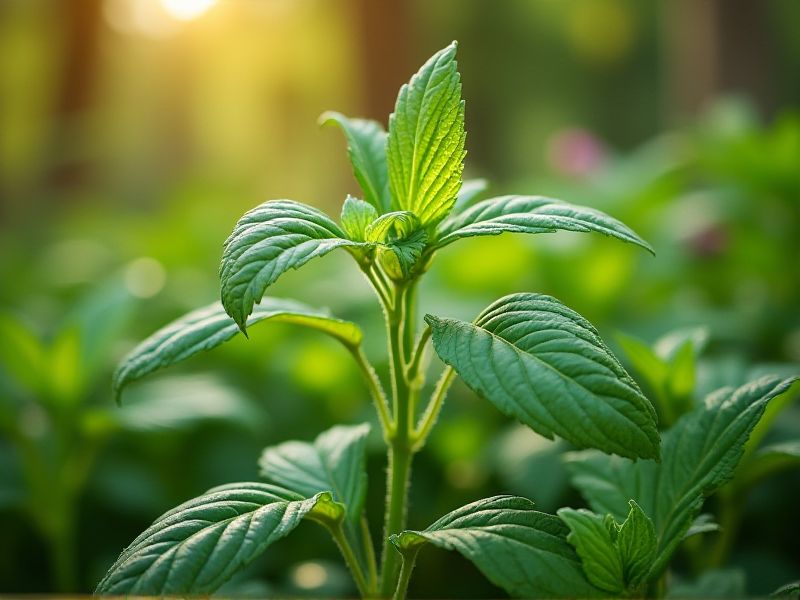
Basil, a staple in Mediterranean cuisine, adds a delightful sweetness and aromatic fragrance to dishes like pasta and salads. Cilantro, known for its bright and zesty flavor, elevates salsas and Asian dishes, making it a versatile herb in your kitchen. Rosemary, with its woodsy and slightly peppery taste, complements roasted meats and hearty stews beautifully. Thyme offers an earthy, slightly minty flavor that enhances everything from soups to roasted vegetables. You can also incorporate chives into your meals for a mild onion flavor that pairs perfectly with eggs and creamy dips.
List of some Herb plants that enhance flavor
- Basil (Ocimum basilicum)
- Rosemary (Salvia rosmarinus)
- Thyme (Thymus vulgaris)
- Oregano (Origanum vulgare)
- Mint (Mentha)
- Parsley (Petroselinum crispum)
- Dill (Anethum graveolens)
- Sage (Salvia officinalis)
- Cilantro (Coriandrum sativum)
- Chives (Allium schoenoprasum)
Important things about Herb plants that enhance flavor
Ideal Growing Conditions
Herb plants such as basil, cilantro, and rosemary thrive in well-drained soil rich in organic matter, allowing their essential oils to flourish, which enhances their flavor profile. Adequate sunlight, ideally six to eight hours per day, is crucial for robust growth and flavor intensity, making a south-facing garden bed or windowsill perfect for cultivation. Maintaining consistent moisture without overwatering is essential, as this prevents root rot and supports strong, aromatic foliage. Harvesting herbs frequently promotes new growth, ensuring your kitchen remains stocked with fresh, flavorful ingredients.
Culinary Uses
Herb plants play a vital role in culinary applications, enhancing the flavor profiles of various dishes. Basil, with its sweet and slightly peppery notes, is commonly used in Italian cuisine, especially in sauces and pesto. Rosemary, characterized by its woody fragrance and robust flavor, complements roasted meats and savory breads. Incorporating herbs like cilantro and parsley not only elevates the taste but also adds a fresh, vibrant look to your meals.
Harvesting Techniques
Proper harvesting techniques significantly influence the flavor profile of herb plants. When you pick herbs in the morning after the dew has dried, their essential oils are at their peak concentration, resulting in a more potent taste. For many varieties, such as basil and mint, cutting stems rather than plucking leaves ensures continued growth and greater flavor retention. Using sharp, clean tools minimizes damage to the plants, promoting healthier regrowth and maintaining the aromatic qualities that enhance your culinary dishes.
Preservation Methods
Herb plants such as basil, cilantro, and rosemary can significantly enhance the flavor of your culinary creations. To preserve these flavorful herbs, consider methods like drying, freezing, or infusing oils, which maintain their aromatic qualities. For drying, hang fresh herbs in a cool, dark place or use a dehydrator to retain their essential oils and flavors. If you prefer to freeze, chop the herbs and mix them with a bit of water or oil, then pour into ice cube trays for convenient flavor additions to future dishes.
Pairing With Foods
Herb plants like basil, cilantro, and rosemary significantly enhance the flavor profiles of various dishes, making them staples in kitchens. Fresh basil complements tomatoes and mozzarella, creating a vibrant Caprese salad, while cilantro adds a fresh zest to salsas and Asian cuisines. Rosemary is particularly effective in elevating roasted meats, enhancing their savory notes with its aromatic qualities. Incorporating these herbs not only amplifies taste but also introduces a nutritious element to your meals.
Flavor Profiles
Herb plants such as basil, rosemary, and cilantro are essential for elevating the flavor of various dishes. Basil imparts a sweet, aromatic essence that pairs beautifully with tomatoes, while rosemary's robust, pine-like flavor enhances meats and roasted vegetables. Cilantro offers a fresh, citrusy kick that brightens salsas and salads, making it a favorite in many cuisines around the globe. By incorporating these vibrant herbs into your cooking, you can transform simple recipes into flavorful culinary experiences.
Growth Cycles
Herb plants such as basil, cilantro, and thyme undergo distinct growth cycles that significantly influence their flavor profiles. Typically, these herbs thrive in well-drained soil and require ample sunlight, with optimal temperatures ranging between 60degF to 75degF for vigorous growth. As they progress from seedling to maturity, their aromatic oils develop, enhancing the taste of your culinary dishes. Regular harvesting encourages bushier growth and more robust flavors, allowing you to enjoy a fresh and fragrant bounty all season long.
Common Pests And Diseases
Herb plants like basil, parsley, and cilantro are not only flavorful additions to your dishes but can also attract pests such as aphids and spider mites, which may compromise their growth. Properly monitoring your herb garden for signs of infestations is essential; organic insecticidal soap can effectively control these pests without harming the plants or the environment. Diseases like downy mildew and fungal infections can also plague herbs, particularly in humid conditions, making it crucial to ensure proper air circulation and avoid overhead watering. Implementing companion planting with pest-repelling herbs, such as marigold or rosemary, can naturally enhance the resilience and flavor of your herb garden.
Soil Requirements
Herb plants that enhance flavor require well-drained, nutrient-rich soil characterized by a pH level ranging from 6.0 to 7.5. For optimal growth, you should incorporate organic matter, such as compost or well-rotted manure, to improve soil structure and fertility. Many culinary herbs, like basil, thyme, and parsley, thrive in loamy soil that retains moisture without becoming waterlogged. Regular soil testing can help you maintain ideal nutrient levels and ensure your herbs grow vibrantly, delivering the rich flavors you desire in your cooking.
Potency Variation
Herb plants such as basil, oregano, and thyme offer remarkable potency variations that significantly enhance culinary flavors. The essential oils in these herbs, like eugenol in basil and thymol in thyme, contribute to their distinct aromatic profiles, elevating the overall taste of dishes. Growing conditions, such as soil quality and sunlight, can affect the potency of these herbs, leading to variations in flavor intensity. To maximize flavor enhancement, consider harvesting your herbs at peak maturity, as this is when their volatile compounds are most concentrated.
